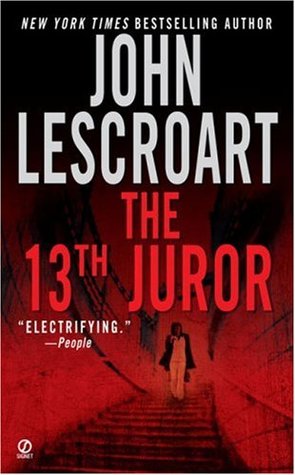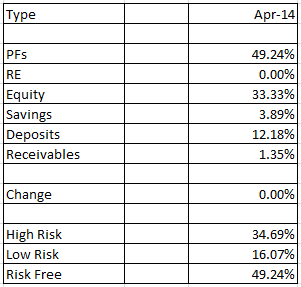Since then, I have managed to read only a handful of legal novels that I really enjoyed.
- The Thirteenth Juror by John Lescroart
- The Firm by John Grisham
- The Client by John Grisham
- The Runaway Jury by John Grisham
The Thirteenth Juror
 This is one of the Dismas Hardy books and the first novel I read belonging to this genre. Unlike most legal novels, this one provides greater coverage of the courtroom drama that is required in such novels. This is what distinguishes a legal novel from other fiction novels, and I feel, authors should try to take advantage of this. As far as this book goes, we have the protagonist Dismas Hardy defending multiple homicide charges against a wife. The prosecution claims that she has murdered her husband and her 8-year old son. This book is loaded on twists, suspense, sentiment and legal drama. When reading such books, one is usually able to root for the innocent or determine the innocent/guilty too - that is certainly not possible in this book. The reader's dilemma in this book extends right to the end and that is truly exhilarating.
This is one of the Dismas Hardy books and the first novel I read belonging to this genre. Unlike most legal novels, this one provides greater coverage of the courtroom drama that is required in such novels. This is what distinguishes a legal novel from other fiction novels, and I feel, authors should try to take advantage of this. As far as this book goes, we have the protagonist Dismas Hardy defending multiple homicide charges against a wife. The prosecution claims that she has murdered her husband and her 8-year old son. This book is loaded on twists, suspense, sentiment and legal drama. When reading such books, one is usually able to root for the innocent or determine the innocent/guilty too - that is certainly not possible in this book. The reader's dilemma in this book extends right to the end and that is truly exhilarating.The Firm
 Strictly speaking, this wouldn't classify as a legal novel(most Grisham books don't, I feel), but it just has to do with a bunch of lawyers in a legal firm. This is more of a thriller/suspense and action kind of book, with some really strange happenings at the firm. A college graduate, Mitch, has offers from the top firms in New York, Chicago etc. but decides to join a small tax firm in Memphis (offers loads of cash/perks). The accidental deaths of multiple lawyers working at the firm has him unsettled and this is where things begin to heat up. Suffice to say, once you have reached this stage, you definitely won't put down the book. There is a great deal of lying, deceit, planning, killing, running etc in this book. It does seem a bit far-fetched when you are done with it, but it's entertaining nonetheless. This is a good one-time read book.
Strictly speaking, this wouldn't classify as a legal novel(most Grisham books don't, I feel), but it just has to do with a bunch of lawyers in a legal firm. This is more of a thriller/suspense and action kind of book, with some really strange happenings at the firm. A college graduate, Mitch, has offers from the top firms in New York, Chicago etc. but decides to join a small tax firm in Memphis (offers loads of cash/perks). The accidental deaths of multiple lawyers working at the firm has him unsettled and this is where things begin to heat up. Suffice to say, once you have reached this stage, you definitely won't put down the book. There is a great deal of lying, deceit, planning, killing, running etc in this book. It does seem a bit far-fetched when you are done with it, but it's entertaining nonetheless. This is a good one-time read book. The Client
The ClientThis book is about a kid who witnesses a suicide and gets caught up in a whole jungle of affairs regarding the dead man's problems. If you've heard the idiom "dead men tell no tales", it certainly does not apply here. With the kid's life at risk, and multiple parties(good and bad) wanting to talk to him about the dead man, he hires himself a lawyer with $1 (what a nice lawyer!). From here on out, it's a wonderful read. That kid is smart, very very smart. With a keen understanding of life and the people around him, the decisions he makes are simply astonishing. This is truly a remarkable read, with a little bit of legal stuff thrown in from time to time.
The Runaway Jury
 Grisham aptly explains the manner in which lawyers(their advisers really) obtain information on the jury candidates, to filter them out and pick the perfect jury for their case. The book starts off with a major case for which the jury is picked and this process is covered in sufficient detail. What makes this book worthwhile - in spite of all that research into the jury candidates, among the jury members picked, there is one person who has hidden motives to swing the verdict in a particular direction. Once the lawyers get a whiff of this intent, book explodes with entertainment. This is definitely a worthwhile read. Although it's a little slow to build up and progress, the satisfaction you obtain when the secrets unfold is immense.
Grisham aptly explains the manner in which lawyers(their advisers really) obtain information on the jury candidates, to filter them out and pick the perfect jury for their case. The book starts off with a major case for which the jury is picked and this process is covered in sufficient detail. What makes this book worthwhile - in spite of all that research into the jury candidates, among the jury members picked, there is one person who has hidden motives to swing the verdict in a particular direction. Once the lawyers get a whiff of this intent, book explodes with entertainment. This is definitely a worthwhile read. Although it's a little slow to build up and progress, the satisfaction you obtain when the secrets unfold is immense.FYI, for all the Grisham books listed above, a movie has been released.
As for the books in this genre currently on my reading list, I don't plan on reading any more Grisham. His books don't truly qualify for the legal novel genre(they are excellent thrillers nonetheless) I enjoyed in The 13th Juror. I'll look forward to reading "To Kill a Mockingbird, by Harper Lee"(highest rated novel in this genre) and the other Dismas Hardy books by John Lescroart next.





